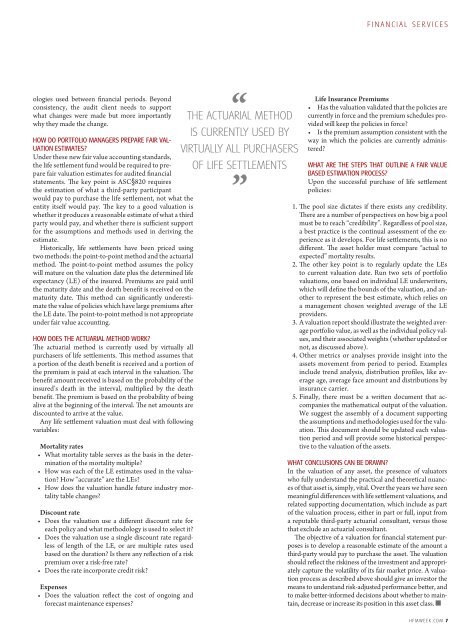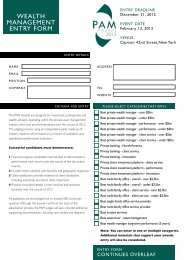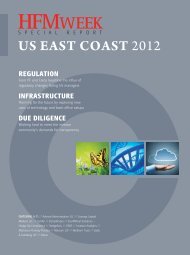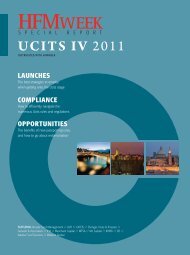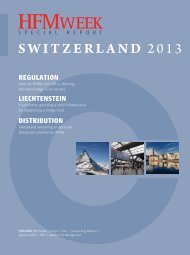CAYMAN 2012 - HFMWeek
CAYMAN 2012 - HFMWeek
CAYMAN 2012 - HFMWeek
- No tags were found...
Create successful ePaper yourself
Turn your PDF publications into a flip-book with our unique Google optimized e-Paper software.
FINANCIAL SERVICES<br />
ologies used between financial periods. Beyond<br />
consistency, the audit client needs to support<br />
what changes were made but more importantly<br />
why they made the change.<br />
HOW DO PORTFOLIO MANAGERS PREPARE FAIR VAL-<br />
UATION ESTIMATES<br />
Under these new fair value accounting standards,<br />
the life settlement fund would be required to prepare<br />
fair valuation estimates for audited financial<br />
statements. The key point is ASC§820 requires<br />
the estimation of what a third-party participant<br />
would pay to purchase the life settlement, not what the<br />
entity itself would pay. The key to a good valuation is<br />
whether it produces a reasonable estimate of what a third<br />
party would pay, and whether there is sufficient support<br />
for the assumptions and methods used in deriving the<br />
estimate.<br />
Historically, life settlements have been priced using<br />
two methods: the point-to-point method and the actuarial<br />
method. The point-to-point method assumes the policy<br />
will mature on the valuation date plus the determined life<br />
expectancy (LE) of the insured. Premiums are paid until<br />
the maturity date and the death benefit is received on the<br />
maturity date. This method can significantly underestimate<br />
the value of policies which have large premiums after<br />
the LE date. The point-to-point method is not appropriate<br />
under fair value accounting.<br />
HOW DOES THE ACTUARIAL METHOD WORK<br />
The actuarial method is currently used by virtually all<br />
purchasers of life settlements. This method assumes that<br />
a portion of the death benefit is received and a portion of<br />
the premium is paid at each interval in the valuation. The<br />
benefit amount received is based on the probability of the<br />
insured’s death in the interval, multiplied by the death<br />
benefit. The premium is based on the probability of being<br />
alive at the beginning of the interval. The net amounts are<br />
discounted to arrive at the value.<br />
Any life settlement valuation must deal with following<br />
variables:<br />
Mortality rates<br />
• What mortality table serves as the basis in the determination<br />
of the mortality multiple<br />
• How was each of the LE estimates used in the valuation<br />
How “accurate” are the LEs<br />
• How does the valuation handle future industry mortality<br />
table changes<br />
Discount rate<br />
• Does the valuation use a different discount rate for<br />
each policy and what methodology is used to select it<br />
• Does the valuation use a single discount rate regardless<br />
of length of the LE, or are multiple rates used<br />
based on the duration Is there any reflection of a risk<br />
premium over a risk-free rate<br />
• Does the rate incorporate credit risk<br />
Expenses<br />
• Does the valuation reflect the cost of ongoing and<br />
forecast maintenance expenses<br />
THE ACTUARIAL METHOD<br />
IS CURRENTLY USED BY<br />
VIRTUALLY ALL PURCHASERS<br />
OF LIFE SETTLEMENTS<br />
”<br />
Life Insurance Premiums<br />
• Has the valuation validated that the policies are<br />
currently in force and the premium schedules provided<br />
will keep the policies in force<br />
• Is the premium assumption consistent with the<br />
way in which the policies are currently administered<br />
WHAT ARE THE STEPS THAT OUTLINE A FAIR VALUE<br />
BASED ESTIMATION PROCESS<br />
Upon the successful purchase of life settlement<br />
policies:<br />
1. The pool size dictates if there exists any credibility.<br />
There are a number of perspectives on how big a pool<br />
must be to reach “credibility”. Regardless of pool size,<br />
a best practice is the continual assessment of the experience<br />
as it develops. For life settlements, this is no<br />
different. The asset holder must compare “actual to<br />
expected” mortality results.<br />
2. The other key point is to regularly update the LEs<br />
to current valuation date. Run two sets of portfolio<br />
valuations, one based on individual LE underwriters,<br />
which will define the bounds of the valuation, and another<br />
to represent the best estimate, which relies on<br />
a management chosen weighted average of the LE<br />
providers.<br />
3. A valuation report should illustrate the weighted average<br />
portfolio value, as well as the individual policy values,<br />
and their associated weights (whether updated or<br />
not, as discussed above).<br />
4. Other metrics or analyses provide insight into the<br />
assets movement from period to period. Examples<br />
include trend analysis, distribution profiles, like average<br />
age, average face amount and distributions by<br />
insurance carrier.<br />
5. Finally, there must be a written document that accompanies<br />
the mathematical output of the valuation.<br />
We suggest the assembly of a document supporting<br />
the assumptions and methodologies used for the valuation.<br />
This document should be updated each valuation<br />
period and will provide some historical perspective<br />
to the valuation of the assets.<br />
WHAT CONCLUSIONS CAN BE DRAWN<br />
In the valuation of any asset, the presence of valuators<br />
who fully understand the practical and theoretical nuances<br />
of that asset is, simply, vital. Over the years we have seen<br />
meaningful differences with life settlement valuations, and<br />
related supporting documentation, which include as part<br />
of the valuation process, either in part or full, input from<br />
a reputable third-party actuarial consultant, versus those<br />
that exclude an actuarial consultant.<br />
The objective of a valuation for financial statement purposes<br />
is to develop a reasonable estimate of the amount a<br />
third-party would pay to purchase the asset. The valuation<br />
should reflect the riskiness of the investment and appropriately<br />
capture the volatility of its fair market price. A valuation<br />
process as described above should give an investor the<br />
means to understand risk-adjusted performance better, and<br />
to make better-informed decisions about whether to maintain,<br />
decrease or increase its position in this asset class. n<br />
HFMWEEK.COM 7


